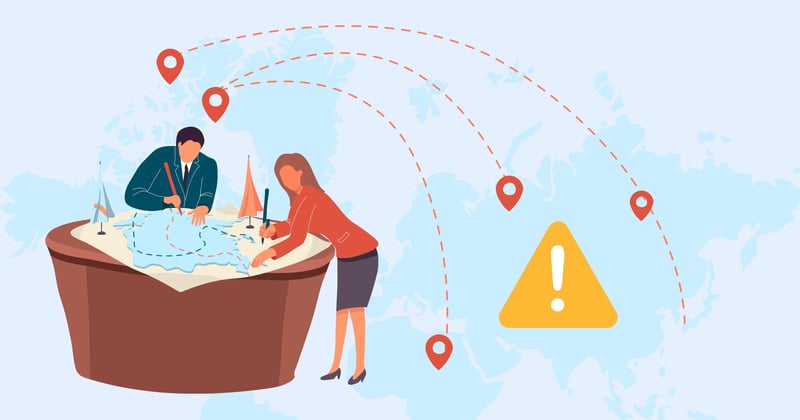The energy sector is increasingly prone to geopolitical risks. The war in Ukraine, economic fluctuations, and supply chain disruptions have all impacted the industry. The energy sector is a crucial infrastructure that uses a web of suppliers that exposes energy companies to high geopolitical risks. Third-party risk management (TPRM) practices can navigate these third-party geopolitical challenges.
Energy companies can use TPRM to assess, monitor, and diversify their third parties. Let’s consider how third-party risk management helps energy companies identify and manage third-party geopolitical risks.
What Are Third-Party Geopolitical Risks in the Energy Industry?
First, it’s crucial to be able to identify the geopolitical risks that third parties pose to your company. Geopolitical risks in the energy industry arise from political dynamics and regulatory changes. These risks can disrupt supply chains, impact market access, and introduce compliance challenges. By understanding the geopolitical landscape, energy companies can better identify and mitigate third-party geopolitical risk.
For example, political instability in a producing country can lead to supply disruptions or unexpected changes in regulations. Trade disputes can result in tariffs or embargoes on energy imports, affecting market dynamics and pricing. Geopolitical tensions in energy-rich regions can lead to conflicts that disrupt production and transportation routes.
Energy companies should closely monitor geopolitical developments and assess the potential impact to ensure operational resilience.

How Third-Party Risk Management Lowers the Energy Industry’s Geopolitical Risks
Energy companies can use third-party risk management to assess how their suppliers expose them to geopolitical risk. This can be done by conducting comprehensive due diligence, evaluating political stability, and analyzing potential trade disruptions.
Did you know? A robust third-party risk management framework can help energy companies better identify, assess, mitigate, and monitor supplier risks, including geopolitical risks. A framework lays the foundation of your third-party risk management program. It establishes the roles, responsibilities, and elements of a successful TPRM program.
Here are some ways TPRM helps energy companies identify and manage geopolitical risks:
- Improved due diligence – When engaging with suppliers, energy companies must thoroughly assess the supplier's geopolitical landscape. With due diligence, energy companies can identify potential compliance and operational risks and implement measures to mitigate them effectively.
- Example: An energy company uses a supplier in a politically unstable region. They face risks of sudden production interruptions or contractual breaches due to civil unrest or regime changes. Similarly, a joint venture with a partner in a country that has evolving regulatory frameworks requires more stringent continuous monitoring and adjustments to ensure compliance. Due diligence catches these issues and allows for energy companies to put the right controls in place to mitigate the risks.
An effective TPRM practice involves conducting due diligence to identify potential issues early on. This allows energy companies to understand the risks in their entire supply chain and properly prepare for them.
- Continuous monitoring – Energy companies should regularly monitor their suppliers and the market for changes. This enables early detection of geopolitical risks, compliance adjustments, and informed decision making. A TPRM program helps energy companies analyze and monitor market and supplier changes, enabling them to adjust compliance and respond to emerging risks.
- Example: An energy company works with government agencies, industry associations, and external experts. They're able to gain insights into regulatory changes and trade policies because of continuous monitoring. That then helps them prepare for geopolitical changes that will impact their company.
- Data analytics – TPRM leverages data analytics to assess geopolitical risks, identify patterns, and anticipate regulatory changes. Analyzing data related to geopolitical events, market trends, and regulatory developments provides valuable insights. That empowers companies to develop proactive compliance strategies like adjusting supply chain routes or diversifying energy
sources. Energy companies should utilize risk intelligence services as well as internet news alerts to gauge public opinion toward policies and projects.
- Example: Energy companies can predict future disruptions by analyzing historical data and market indicators, identifying patterns in geopolitical risks. This provides valuable insight and foresight.
- Diversify suppliers – It’s essential to decrease reliance on specific regions in the energy sector by diversifying suppliers and exploring alternative sources of energy, such as renewables or natural gas, to mitigate geopolitical risks. Forming partnerships in politically stable regions diversifies market access and helps ensure a stable customer base. Energy companies can use third-party risk management to broaden their supplier base and investigate alternate energy sources to reduce geopolitical risks.
- Example: A company that depends on one country for their oil imports is at risk of experiencing significant setbacks if political tensions or conflicts arise in that region. However, they can utilize TPRM to discover alternative suppliers, research diverse energy sources, and form more politically stable partnerships.
- Gain a competitive advantage – Energy companies can explore new markets to reduce geopolitical risks. Expanding into new markets can provide opportunities for growth and diversification, reducing reliance on a single market that may be prone to geopolitical instabilities. TPRM can help identify and evaluate the level of geopolitical risks in these new markets.
- Example: A company focused on energy production in one country plans to expand into a neighboring country with favorable political and regulatory conditions. By diversifying their presence into multiple markets, they can minimize the impact of geopolitical risks in specific areas and achieve a more balanced and resilient market position.
Regular monitoring and reporting allow energy companies to stay vigilant and respond to changes in the geopolitical landscape. Implementing effective TPRM practices can aid energy companies in managing geopolitical risks and improving compliance. TPRM helps companies anticipate and manage geopolitical risks, ensuring operational resilience, sustained compliance, and a secure energy ecosystem.






.gif?width=1920&name=Sample-Graphic-Animation%20(1).gif)




